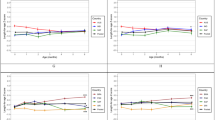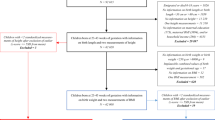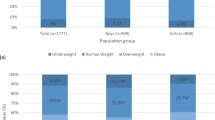Abstract
Background:
Weight and weight gain throughout infancy are related to later obesity, but whether the strength of the associations varies during the infancy period is uncertain.
Aims:
Our aims were to identify the period of infancy when change in body weight has the strongest association with adult body mass index (BMI) and also the extent to which these associations during infancy are mediated through childhood BMI.
Methods:
The Copenhagen Perinatal Cohort, in which participants were followed from birth through 42 years of age, provided information on weight at 12 months and BMI at 42 years for 1633 individuals. Information on weight at birth, 2 weeks, 1, 2, 3, 4 and 6 months was retrieved from health visitors’ records and information on BMI at ages 7 and 13 years from school health records. The associations of infant weight and weight gain standard deviation scores (SDS) with adult BMI-SDS were analyzed using multiple linear regression and path analysis.
Results:
Higher-weight-SDS at all ages from birth to an age 12 months were associated with higher-BMI-SDS at 42 years (regression coefficients 0.08–0.12). Infant weight gain-SDS was associated with greater BMI-SDS at 42 years only between birth and 3 months (0.09, 95% confidence intervals (CI) 0.04, 0.15) driven by an association between 2 and 3 months (0.12, 95% CI: 0.04, 0.20). The latter was partly mediated through later BMI in the path analysis. Infant weight gain-SDS between 3 and 12 months was not associated with greater BMI-SDS at 42 years.
Conclusions:
Faster weight gain during only the first 3 months of infancy was associated with increased adult BMI, although not in a consistent monthly pattern. Adult BMI is more sensitive to high weight gain during early infancy than late infancy, but not specifically to the first month of life.
This is a preview of subscription content, access via your institution
Access options
Subscribe to this journal
Receive 12 print issues and online access
$259.00 per year
only $21.58 per issue
Buy this article
- Purchase on Springer Link
- Instant access to full article PDF
Prices may be subject to local taxes which are calculated during checkout



Similar content being viewed by others
References
Moss BG, Yeaton WH . Young children's weight trajectories and associated risk factors: results from the early childhood longitudinal study-birth cohort. Am J Health Promot 2011; 25: 190–198.
Cattaneo A, Monasta L, Stamatakis E, Lioret S, Castetbon K, Frenken F et al. Overweight and obesity in infants and pre-school children in the European Union: a review of existing data. Obes Rev 2010; 11: 389–398.
McCormick DP, Sarpong K, Jordan L, Ray LA, Jain S . Infant obesity: are we ready to make this diagnosis? J Pediatr 2010; 157: 15–19.
Gillman MW . The first months of life: a critical period for development of obesity. Am J Clin Nutr 2008; 87: 1587–1589.
Hesketh KD, Campbell KJ . Interventions to prevent obesity in 0-5 year olds: an updated systematic review of the literature. Obesity (Silver Spring) 2010; 18 (Suppl 1): S27–S35.
Singhal A, Lucas A . Early origins of cardiovascular disease: is there a unifying hypothesis? Lancet 2004; 363: 1642–1645.
Baird J, Fisher D, Lucas P, Kleijnen J, Roberts H, Law C . Being big or growing fast: systematic review of size and growth in infancy and later obesity. BMJ 2005; 331: 929.
Druet C, Stettler N, Sharp S, Simmons RK, Cooper C, Davey Smith G et al. Prediction of childhood obesity by infancy weight gain: an individual-level meta-analysis. Paediatr Perinat Epidemiol 2012; 26: 19–26.
Monteiro PO, Victora CG . Rapid growth in infancy and childhood and obesity in later life–a systematic review. Obes Rev 2005; 6: 143–154.
Ong KK, Loos RJ . Rapid infancy weight gain and subsequent obesity: systematic reviews and hopeful suggestions. Acta Paediatr 2006; 95: 904–908.
Stocks T, Renders CM, Bulk-Bunschoten AM, Hirasing RA, van BS, Seidell JC . Body size and growth in 0- to 4-year-old children and the relation to body size in primary school age. Obes Rev 2011; 12: 637–652.
Dewey KG, Heinig MJ, Nommsen LA, Peerson JM, Lonnerdal B . Growth of breast-fed and formula-fed infants from 0 to 18 months: the DARLING Study. Pediatrics 1992; 89: 1035–1041.
Horta BL, Bahl R, Martines JC, Victora CG . Evidence oP Long-term Effects of Breastfeeding: Systematic Review and Meta-analyses. World Health Organization: Geneva, Switzerland, 2007.
Schack-Nielsen L, Sørensen TIA, Mortensen EL, Michaelsen KF . Late introduction of complementary feeding, rather than duration of breastfeeding, may protect against adult overweight. Am J Clin Nutr 2010; 91: 619–627.
Karaolis-Danckert N, Gunther AL, Kroke A, Hornberg C, Buyken AE . How early dietary factors modify the effect of rapid weight gain in infancy on subsequent body-composition development in term children whose birth weight was appropriate for gestational age. Am J Clin Nutr 2007; 86: 1700–1708.
Dennison BA, Edmunds LS, Stratton HH, Pruzek RM . Rapid infant weight gain predicts childhood overweight. Obesity (Silver Spring) 2006; 14: 491–499.
Young BE, Johnson SL, Krebs NF . Biological determinants linking infant weight gain and child obesity: current knowledge and future directions. Adv Nutr 2012; 3: 675–686.
Andersen LG, Holst C, Michaelsen KF, Baker JL, Sørensen TIA . Weight and weight gain during early infancy predict childhood obesity: a case-cohort study. Int J Obes (Lond) 2012; 36: 1306–1311.
Stettler N, Kumanyika SK, Katz SH, Zemel BS, Stallings VA . Rapid weight gain during infancy and obesity in young adulthood in a cohort of African Americans. Am J Clin Nutr 2003; 77: 1374–1378.
Leunissen RW, Kerkhof GF, Stijnen T, Hokken-Koelega A . Timing and tempo of first-year rapid growth in relation to cardiovascular and metabolic risk profile in early adulthood. JAMA 2009; 301: 2234–2242.
Larnkjær A, Schack-Nielsen L, Mølgaard C, Ingstrup HK, Holst JJ, Michaelsen KF . Effect of growth in infancy on body composition, insulin resistance, and concentration of appetite hormones in adolescence. Am J Clin Nutr 2010; 91: 1675–1683.
Stettler N, Stallings VA, Troxel AB, Zhao J, Schinnar R, Nelson SE et al. Weight gain in the first week of life and overweight in adulthood: a cohort study of European American subjects fed infant formula. Circulation 2005; 111: 1897–1903.
Slining MM, Kuzawa CW, Mayer-Davis EJ, Adair LS . Evaluating the indirect effect of infant weight velocity on insulin resistance in young adulthood: a birth cohort study from the Philippines. Am J Epidemiol 2011; 173: 640–648.
McCarthy A, Hughes R, Tilling K, Davies D, Smith GD, Ben-Shlomo Y . Birth weight; postnatal, infant, and childhood growth; and obesity in young adulthood: evidence from the Barry Caerphilly Growth Study. Am J Clin Nutr 2007; 86: 907–913.
Sachdev HS, Fall CH, Osmond C, Lakshmy R, Dey Biswas SK, Leary SD et al. Anthropometric indicators of body composition in young adults: relation to size at birth and serial measurements of body mass index in childhood in the New Delhi birth cohort. Am J Clin Nutr 2005; 82: 456–466.
Willumsen AL . Environmental Factors in Congenital Malformations: A Prospective Study of 9006 Human Pregnancies. F.A.D.L.'s Forlag: Copenhagen, Denmark 1970.
Zachau-Christiansen B, Ross EM . Babies: Human Development During the first Year. John Wiley & Sons Ltd.: London, 1975.
Biering-Sørensen F, Hilden J, Biering-Sørensen K . Breast-feeding in Copenhagen, 1938-1977. Data on more than 365,000 infants. Dan Med Bull 1980; 27: 42–48.
Baker JL, Olsen LW, Andersen I, Pearson S, Hansen B, Sørensen TIA . Cohort profile: the copenhagen school health records register. Int J Epidemiol 2009; 38: 656–662.
Hilden J, Biering-Sørensen K, Biering-Sørensen F . Contraceptives and the new trend in breast-feeding–a causal connection? J Trop Pediatr 1983; 29: 40–44.
Svalastoga K, Wolf P . Prestige, class and mobility. In: Social rang og mobilitet, 2nd edn. Gyldendal: København, Denmark, 1969.
Teasdale TW . Social class correlations among adoptees and their biological and adoptive parents. Behav Genet 1979; 9: 103–114.
Indenrigsministeriets helbredsudvalg, Sundhedsstyrelsen, Den Danske Almindelige Lægeforenings Hygiejnekomité. Lille Ny Vejledning for Vordende mødre. Sundhedsstyrelsen, Copenhagen, 1960.
Gamborg M, Andersen PK, Baker JL, Bugel S, Jørgensen T, Jensen G et al. Life course path analysis of birth weight, childhood growth, and adult systolic blood pressure. Am J Epidemiol 2009; 169: 1167–1178.
StataCorp. Stata statistical software: release 12. Stata Corp LP: College Station, TX, USA, 2011.
Little R, Rubin DB . Statistical Analysis With Missing Data. John Wiley & Sons: New York, NY, USA, 2002.
Greenland S, Pearl J, Robins JM . Causal diagrams for epidemiologic research. Epidemiology 1999; 10: 37–48.
Svendsen OL . Should measurement of body composition influence therapy for obesity? Acta Diabetol 2003; 40 (Suppl 1): S250–S253.
Ong KK, Emmett P, Northstone K, Golding J, Rogers I, Ness AR et al. Infancy weight gain predicts childhood body fat and age at menarche in girls. J Clin Endocrinol Metab 2009; 94: 1527–1532.
Chomtho S, Wells JC, Williams JE, Davies PS, Lucas A, Fewtrell MS . Infant growth and later body composition: evidence from the 4-component model. Am J Clin Nutr 2008; 87: 1776–1784.
Karaolis-Danckert N, Buyken AE, Bolzenius K, Perim de FC, Lentze MJ, Kroke A . Rapid growth among term children whose birth weight was appropriate for gestational age has a longer lasting effect on body fat percentage than on body mass index. Am J Clin Nutr 2006; 84: 1449–1455.
Eriksson M, Tynelius P, Rasmussen F . Associations of birthweight and infant growth with body composition at age 15–the COMPASS study. Paediatr Perinat Epidemiol 2008; 22: 379–388.
Larnkjaer A, Schack-Nielsen L, Molgaard C, Ingstrup HK, Holst JJ, Michaelsen KF . Effect of growth in infancy on body composition, insulin resistance, and concentration of appetite hormones in adolescence. Am J Clin Nutr 2010; 91: 1675–1683.
Ekelund U, Ong K, Linne Y, Neovius M, Brage S, Dunger DB et al. Upward weight percentile crossing in infancy and early childhood independently predicts fat mass in young adults: the Stockholm Weight Development Study (SWEDES). Am J Clin Nutr 2006; 83: 324–330.
Demerath EW, Reed D, Choh AC, Soloway L, Lee M, Czerwinski SA et al. Rapid postnatal weight gain and visceral adiposity in adulthood: the Fels Longitudinal Study. Obesity (Silver Spring) 2009; 17: 2060–2066.
Wells JC, Hallal PC, Wright A, Singhal A, Victora CG . Fetal, infant and childhood growth: relationships with body composition in Brazilian boys aged 9 years. Int J Obes (Lond) 2005; 29: 1192–1198.
Singh AS, Mulder C, Twisk JW, van MW, Chinapaw MJ . Tracking of childhood overweight into adulthood: a systematic review of the literature. Obes Rev 2008; 9: 474–488.
Baker JL, Michaelsen KF, Rasmussen KM, Sørensen TIA . Maternal prepregnant body mass index, duration of breastfeeding, and timing of complementary food introduction are associated with infant weight gain. Am J Clin Nutr 2004; 80: 1579–1588.
Rasmussen KM . Association of maternal obesity before conception with poor lactation performance. Annu Rev Nutr 2007; 27: 103–121.
Kronborg H, Vaeth M, Rasmussen KM . Obesity and early cessation of breastfeeding in Denmark. Eur J Public Health 2013; 23: 316–322.
Whitaker RC, Wright JA, Pepe MS, Seidel KD, Dietz WH . Predicting obesity in young adulthood from childhood and parental obesity. N Engl J Med 1997; 337: 869–873.
Li C, Kaur H, Choi WS, Huang TT, Lee RE, Ahluwalia JS . Additive interactions of maternal prepregnancy BMI and breast-feeding on childhood overweight. Obes Res 2005; 13: 362–371.
Michaelsen KF, Greer FR . Protein needs early in life and long-term health. Am J Clin Nutr 2014; 99: 718S–722S.
Kramer MS, Moodie EE, Dahhou M, Platt RW . Breastfeeding and infant size: evidence of reverse causality. Am J Epidemiol 2011; 173: 978–983.
Marquis GS, Habicht JP, Lanata CF, Black RE, Rasmussen KM . Association of breastfeeding and stunting in Peruvian toddlers: an example of reverse causality. Int J Epidemiol 1997; 26: 349–356.
Fomon S . Infant feeding in the 20th century: formula and beikost. J Nutr 2001; 131: 409S–420S.
Acknowledgements
We are grateful for the collection of the Copenhagen Perinatal Cohort data led by the late Drs Aage Willumsen and Bengt Zachau-Christiansen. We thank Helga Kvistgaard for assistance with the infant health visitor records data, current and former infant health visitors Charlotte Westerlin Nielsen, Ruth Lewkowitz, Inga Axelsen, Anna Grosen, Elisabeth Olsson and Birte Sørensen for information about the infant health visitors’ system in the 1960s, and Claus Holst and Michael Gamborg for advice on statistical analysis. This study received support from the Danish Heart Foundation, the Rosalie Petersen’s Foundation, the Aase and Ejner Danielsen’s Foundation, the Lundbeck Foundation (R13-A1317), the Danish PhD School of Molecular Metabolism, the University of Copenhagen, the Novo Nordisk Foundation and the Capital region of Denmark. This work was carried out as a part of the research program of the Danish Obesity Research Center (DanORC). DanORC is supported by the Danish Council for Strategic Research (grant 2101–06–0005).
Author Contributions
The authors' responsibilities were as follows: TIAS initiated the research; TIAS, JLB, KFM, LGB and KMR designed the research; TIAS and ELM provided the data; AS constructed databases; LGB conducted the analyses and drafted the paper. All authors read, commented on and approved the final manuscript.
Author information
Authors and Affiliations
Corresponding author
Ethics declarations
Competing interests
The authors declare no conflict of interest.
Additional information
Supplementary Information accompanies this paper on International Journal of Obesity website
Rights and permissions
About this article
Cite this article
Bjerregaard, L., Rasmussen, K., Michaelsen, K. et al. Effects of body size and change in body size from infancy through childhood on body mass index in adulthood. Int J Obes 38, 1305–1311 (2014). https://doi.org/10.1038/ijo.2014.108
Received:
Revised:
Accepted:
Published:
Issue Date:
DOI: https://doi.org/10.1038/ijo.2014.108



